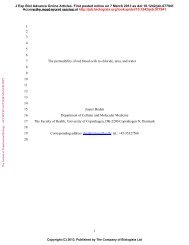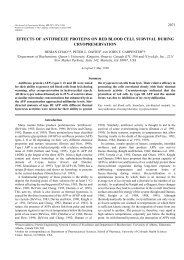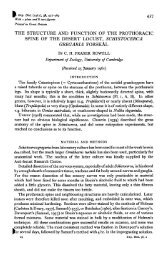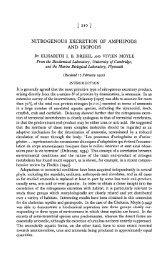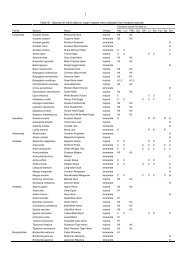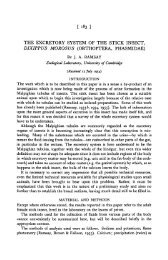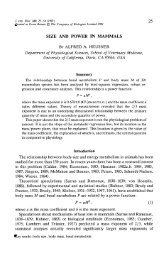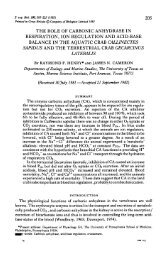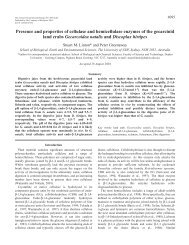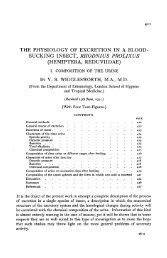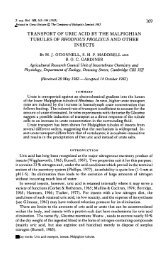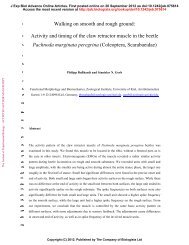the functional design of the insect excretory system - The Journal of ...
the functional design of the insect excretory system - The Journal of ...
the functional design of the insect excretory system - The Journal of ...
You also want an ePaper? Increase the reach of your titles
YUMPU automatically turns print PDFs into web optimized ePapers that Google loves.
<strong>The</strong> <strong>functional</strong> <strong>design</strong> <strong>of</strong> <strong>the</strong> <strong>insect</strong> <strong>excretory</strong> <strong>system</strong><br />
Table 2. Insects for which <strong>the</strong>re is evidence that <strong>the</strong> rate <strong>of</strong> fluid transport<br />
by <strong>the</strong>ir Malpighian tubules is regulated by hormones<br />
Order Species References<br />
Hymenoptera Apis mellifera Altmann (1956)<br />
Diptera<br />
Lepidoptera<br />
Coleoptera<br />
Hemiptera<br />
Orthoptera<br />
Calliphora vomitoria<br />
CaUiphora erythrocephala<br />
Glossina morsitans<br />
Aedes taemorhynchus<br />
Anopheles freeborni<br />
Pieris brassicae<br />
Calpodes ethlius<br />
Danaus plexippus<br />
Anisotarsus cupripennis<br />
Rhodnius prolixus<br />
Triatoma ivjestans<br />
Triatoma phyllosoma<br />
Dipetalogaster maxima<br />
Dysdercus fasciatus<br />
Periplaneta americana<br />
Locus ta rmgratoria<br />
Schxstocerca gregaria<br />
Carausius morosus<br />
Acheta domes tua<br />
Knowles(i976)<br />
Schwartz & Reynolds (1979)<br />
Gee (197s)<br />
Maddrell & Phillips (1978)<br />
Nijhout & Carrow (1978)<br />
Nicolson(i976)<br />
Ryerse(i978)<br />
Dores, Dallman & Nerman (1979)<br />
Nufiez(i9s6)<br />
Maddrell (1962)<br />
Maddrell (unpublished results)<br />
Maddrell (unpublished results)<br />
Maddrell (unpublished results)<br />
Berridge(i966)<br />
Mills (1967)<br />
Cazal&Girardie(i968)<br />
Mordue(i969)<br />
Pilcher(i97o)<br />
Geldiay & Edwards (1976)<br />
rapidly. Appropriately, flying locusts release hormone(8) to accelerate both fluid secretion<br />
by <strong>the</strong>ir Malpighian tubules and fluid reabsorption in <strong>the</strong> hindgut (Mordue, 1969).<br />
If we accept that <strong>insect</strong>s need to be able to secrete fluid at a range <strong>of</strong> rates, <strong>the</strong>n it<br />
now becomes clear why <strong>the</strong> Malpighian tubules have to have a considerable area <strong>of</strong><br />
fluid secreting epi<strong>the</strong>lium, and this <strong>the</strong> tubule cells provide.<br />
ADVANTAGES OF AN EXCRETORY SYSTEM WITH RESTRICTED •<br />
PERMEABLE SITES FOR FILTRATION<br />
What advantages do <strong>insect</strong>s derive from <strong>the</strong>ir somewhat unusual <strong>excretory</strong> <strong>system</strong> ?<br />
As will be clear from what has already been said, an obvious advantage <strong>of</strong> a <strong>system</strong><br />
which operates slowly is that reabsorption <strong>of</strong> useful substances from <strong>the</strong> filtered fluid<br />
need only be slow. Presumably <strong>the</strong> fluid flow in <strong>the</strong> <strong>system</strong> need also only be slow, at<br />
least when no hormonal stimulation <strong>of</strong> secretion goes on. It is possible to check this<br />
point by reference to <strong>the</strong> known rates <strong>of</strong> Malpighian tubule fluid production. Table 3<br />
compares <strong>the</strong> rates at which <strong>the</strong> extracellular fluid is passed through <strong>the</strong> <strong>excretory</strong><br />
<strong>system</strong> <strong>of</strong> <strong>insect</strong>s with similar figures for vertebrates. Clearly, most vertebrates filter<br />
<strong>the</strong>ir extracellular fluid 10-20 times more rapidly than do most <strong>insect</strong>s. Taking into<br />
account <strong>the</strong> fact that, in <strong>insect</strong>s, many haemolymph solutes <strong>of</strong> even quite small<br />
molecular size only appear in <strong>the</strong> filtered fluid at concentrations in <strong>the</strong> range 10-50%<br />
<strong>of</strong> those in <strong>the</strong> haemolymph, it is clear that reabsorption <strong>of</strong> such solutes need only<br />
occur in <strong>insect</strong>s at about 1-2% <strong>of</strong> <strong>the</strong> rate required in many vertebrates.<br />
<strong>The</strong> figures in Table 3 for a snake and a frog suggest that filtration <strong>of</strong> extracellular<br />
fluid may be slower in ecto<strong>the</strong>rmic animals, perhaps reflecting <strong>the</strong>ir lower rates <strong>of</strong><br />
metabolism. If so, <strong>the</strong>n <strong>the</strong> slow rate at which <strong>insect</strong>s pass fluid through <strong>the</strong>ir Malpighian<br />
tubules might be attributable more to <strong>the</strong> fact <strong>the</strong>y are ecto<strong>the</strong>rms than to




